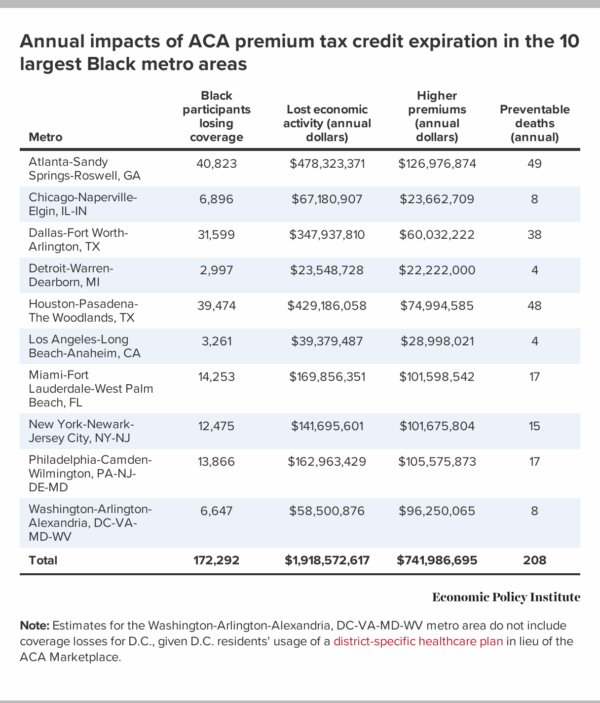Ending ACA tax credits would impose high costs on Black Americans in 10 major metro areas: Over 170,000 losing health insurance, $740 million more in annual premiums, and more than 200 preventable deaths each year
If Congress allows the enhanced Affordable Care Act (ACA) premium tax credits to expire, millions of working families will lose health care coverage while millions of others will face sharply higher premiums. With four Republicans breaking ranks to vote with Democrats and force a House vote on whether to extend the credits, Congress now has a chance to avert this crisis. Losing the tax credits would be an added blow for households already squeezed by rising costs and tight budgets. But a deeper story emerges when we look at who stands to lose the most. A forthcoming analysis from the Economic Policy Institute and Groundwork Collaborative finds that Black Americans in some of the nation’s largest metropolitan areas would face deep coverage losses and financial harm if credits expire.1

This analysis was produced in partnership with Groundwork Collaborative.
More than 170,000 Black adults in 10 major metro areas would lose health care coverage in 2026 if the ACA credits expire, with the largest losses in Atlanta, Houston, Dallas, and Miami. Losing insurance wipes away a basic source of security for working families and reverses gains made under the ACA, which disproportionately reduced uninsured rates for Black adults—narrowing longstanding racial coverage gaps.
Our analysis shows that coverage loss is only the first shock. Families who lose insurance and families who remain covered both face significant new burdens, and the costs are substantial across the 10 metropolitan areas.
- Allowing the ACA credits to expire would lead to more than 200 preventable Black deaths each year. These deaths stem directly from the loss of affordable coverage and reduced access to timely care.
- Black families would pay $740 million more in annual premium costs. Black families who are able to keep their health insurance would be squeezed by higher health care costs, further straining already tight household budgets.
- Local economies in major metros with large Black populations would lose more than $1.9 billion each year. Atlanta, Houston, and Dallas metros would lose the most economic activity as federal subsidies disappear and household spending contracts because families must redirect more of their income toward higher premiums and away from spending on local goods and services.

Allowing the ACA premium tax credits to expire would make it harder for U.S. families to access health care, worsen an ongoing affordability crisis, and negatively impact local economies. These shocks would be felt acutely by Black workers and their families because they reflect longstanding structural inequities that influence who has access to affordable health care. Black workers are less likely to hold jobs that provide employer-provided health insurance, more likely to live in states that did not expand Medicaid, and more likely to skip or delay medical care due to costs. Moreover, ending the tax credits would reduce economic activity and lower productivity in the cities where Black families live.
The pursuit of equity in this moment requires us to hold fast to the gains we have made thus far, both to limit the suffering of as many U.S. families as possible and to help us build toward further progress. Acting to extend the ACA premium tax credits until such a time that health costs can be significantly reduced is smart, responsible, and race-conscious economic and public health policy.
Note1. Pre-Trump economic conditions were examined in these 10 metro areas in EPI’s “A tale of 10 cities” report, which discusses various threats imposed by the Trump administration’s historic rollback of federal, civil, and workers’ rights protections. The underlying methodology combines Census microdata, federal Marketplace enrollment data, and state-level projections of coverage loss. The forthcoming report will provide complete technical details.

Recent comments